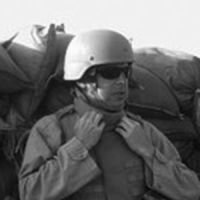In the final pages of Elliot Ackerman’s debut novel, Green On Blue, is an observation about separation often made about wartime efforts in Iraq and Afghanistan, the setting for the book: “Across the high plain, tucked among the foothills, is FOB Sharana. At night, its towers are all that can be seen. The Americans wall themselves in with a ring of lights. While everyone sleeps, only they run their generators.”
American soldiers stayed on their bases, often too distant from the nations they supposedly strove to help. This criticism could be leveled at much recent war-related fiction and nonfiction. Authors have presented high-powered, well-lit portrayals of American soldiers. But that writing light can shine too brightly on the familiar exploits of U.S.-centric characters; it blinds us to the lives on the other side of an American fighting base’s concrete-walled borders, in the dark corners where floodlights cannot reach.
Green on Blue sends up an illumination round, revealing that world of shadow. Ackerman’s clear empathy for Afghanistan helps drive a graceful narrative that never bogs down in battlefield histrionics. He uses his experience as an adviser with an Afghan commando battalion to poignantly inform, not exploit, the stories of his Afghan characters. The reader is swept along on a river of regret, recrimination and destiny in a grand novel about the saddest star-crossed hopes.
ADVERTISEMENT
Instead of the familiar Humvee, the war in Green on Blue is fought from worn-down Toyota Hi-Lux pickup trucks whose “loose-jointed doors, tailgates and hoods rattled,” the Afghan narrator Aziz relates. “The Hi-Lux was an economical choice and usually reliable.”
Aziz, a boy turned soldier, is another “economical choice” the U.S. advisers have recruited in forming an Afghan fighting force. Aziz becomes a member of the Special Lashkar, a U.S.-funded militia made up of Afghans with varying motivations. Aziz joins to earn medical care for his brother, injured in a bombing.
American writers have tackled the “locals” in war literature before, but the examples are few and far between. Michael Pitre’s Fives and Twenty-Fives featured Kateb, an Iraqi interpreter working alongside U.S. soldiers. And in 2004, Dan Fesperman’s The Warlord’s Son presented Najeeb, an Afghan “fixer-translator-driver” for an American war correspondent. Marketed as a genre thriller set in Pakistan-Afghan tribal areas, The Warlord’s Son was ahead of its time in its nuanced portrayal of Najeeb, who navigates Pakistani intelligence services, tribal warlords, and his protective relationship with the American reporter who is blissfully unaware of the shifting allegiances of all those around him.
In Green on Blue’s character of Aziz, Ackerman has given readers an equally well-drawn protagonist. Aziz is so refreshingly real because he is so new, especially in our current literary marketplace. The U.S. soldiers portrayed in recent war literature, fiction and nonfiction, can seem to run namelessly together, just like the body armor and dark black eye protection made them look so alike in real life.
And maybe it took this last decade for American readers to finally be willing to experience the war from the point of view of our Afghan allies.
Of course, by 2015, the common ground we once saw in that alliance has long been corrupted. Ackerman’s provocative title evokes the instances of U.S. soldiers killed by their supposed Afghan allies in so-called “green on blue” attacks—a distant cousin of “friendly fire.”
The term itself is antiseptic military jargon. Colors on maps often designate local national forces, such as the Afghan army, as “green” and U.S. forces as “blue.”
The root of “green-on-blue” attacks can be seen as revenge against the occupying forces, and this novel is about revenge—what it takes and what it costs. Badal (vengeance) and nang (honor) consistently drive the motivations of the characters in the story. The narrative’s lack of a constant American presence means the reader does not have the conflicting perspective of our “normal” cultural behavior.
Consequently, a reader quickly understands the Afghan point of view: Aziz must take badal against the warlord responsible for his brother’s injuries; there is no other acceptable option. Another character flees a feud, willing to die alone, rather than have his father die to protect him, imploring his brother, “your badal is to take none,” upon the brother’s certain death. “Break the chain. Care for father. Leave the war.” The heartbreak is that breaking that chain of vengeance means giving up how they are expected to live.
And even when it’s done, when badal is accomplished and nang restored, it fills no gap; all that’s left is the war and “the war sustains us,” a warlord wistfully explains. “It can be a life.”
There are moments of levity. Omar, a one-eyed goldfish, is left gasping on the floor when his warlord owner accidentally upends his small bowl, but is saved by Aziz’s frantic actions. And Omar’s fish food is the only gift a warlord is willing to accept from Mr. Jack, the narrative’s only ghostly American who comes and goes, directing—or so he thinks—the actions of his Afghan minions.
Amid the violence and catastrophe, Ackerman seems to present the idea that hope might be the worst thing that Afghanistan offers—especially to those most invested in its endless wars—in the way Aziz hopes he can find a way to keep medicine coming to a crippled young woman he has begun to love. Or if hope is not the worst thing, then ambition. Aziz’s ambition lets him believe that perhaps he can save this girl and protect his brother, that he can leverage the Americans behind their walls and towers, that he can fool a warlord, that he can become a warlord.
In the last line, as Aziz tries to wash himself clean, the reader understands how all of Afghanistan’s mini-tyrants and would-be saviors have come and gone.
Nathan S. Webster is a lecturer of English at the University of New Hampshire. A U.S. Army veteran of Desert Storm, he reported from Iraq as a freelance photojournalist from 2007 to 2009.





